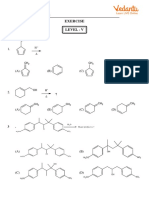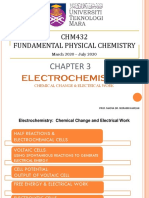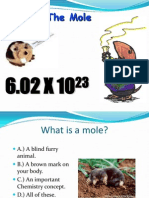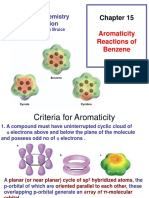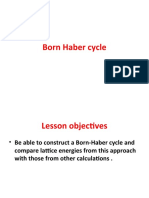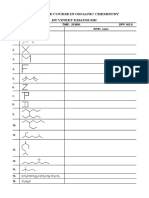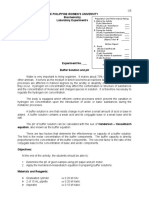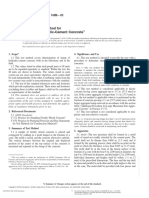Unit 4: Thermochemistry and Nuclear Chemistry Chemistry AP Chapter 23: Nuclear Chemistry 23.1: The Nature of Nuclear Reactions
Unit 4: Thermochemistry and Nuclear Chemistry Chemistry AP Chapter 23: Nuclear Chemistry 23.1: The Nature of Nuclear Reactions
Uploaded by
Pankaj KumarCopyright:
Available Formats
Unit 4: Thermochemistry and Nuclear Chemistry Chemistry AP Chapter 23: Nuclear Chemistry 23.1: The Nature of Nuclear Reactions
Unit 4: Thermochemistry and Nuclear Chemistry Chemistry AP Chapter 23: Nuclear Chemistry 23.1: The Nature of Nuclear Reactions
Uploaded by
Pankaj KumarOriginal Description:
Original Title
Copyright
Available Formats
Share this document
Did you find this document useful?
Is this content inappropriate?
Copyright:
Available Formats
Unit 4: Thermochemistry and Nuclear Chemistry Chemistry AP Chapter 23: Nuclear Chemistry 23.1: The Nature of Nuclear Reactions
Unit 4: Thermochemistry and Nuclear Chemistry Chemistry AP Chapter 23: Nuclear Chemistry 23.1: The Nature of Nuclear Reactions
Uploaded by
Pankaj KumarCopyright:
Available Formats
Unit 4: Thermochemistry and Nuclear Chemistry Chemistry AP
Page 230. Copyrighted by Gabriel Tang B.Ed., B.Sc.
Chapter 23: Nuclear Chemistry
23.1: The Nature of Nuclear Reactions
Nucleons: - the particles that make up a nucleus of an atom (protons,(
1
1
p
+
or
1
1
H)
and neutrons, (
1
0
n)).
Isotopes: - atoms that have different mass number but the same atomic number or number of protons.
Nuclide: a particular atom or isotope containing specific numbers of protons and neutrons
Radioactivity: - the particles and/or electromagnetic radiation that are emitted due to unstable nuclei.
- all elements having atomic number 84 (Polonium) and greater are radioactive.
Nuclear Transmutation: - a process where radioactivity is resulted from the bombardment of nuclei by
neutrons, protons or other nuclei.
- in most cases, heavier elements are synthesized from lighter elements.
History of Radioactivity
In 1896, Wilhelm Roentgen discovered X-ray by examining ray emitting from the outside of the
cathode ray glass tube. It has the capability of passing through solid materials, but can be blocked by
denser matters. It can also be exposed to photographic plate, resulting from an image of seeing
through an container made of less dense material.
In the same year, Antoine Becquerel discovered that uranium emits a ray onto a photographic plate in
the absence of sunlight or other forms of energy.
A few years later, Marie and Pierre Curie demonstrated that radiation can be emitted by other
elements. They discovered two new elements (polonium and radium) based on their tendency to emit
radiation (radioactivity).
Types of Radioactive Particle and Decay
1. Alpha Particle ( particle): - basically a helium nucleus (
4
2
He), commonly found during radioactive
decay from heavier nuclide (the net result is to increase the neutron to
proton ratio more explanation in the next section).
Example: Po
218
84
Pb
214
82
+
4
2
He
2. Beta Particle ( particle): - basically an electron (
0
1
e or
0
1
) that is emitted when the neutron to proton
ratio is higher than the zone of stability (a neutron is transformed to a
proton and an electron as a result more explanation in the next section).
- electrons have a mass number of 0 and an atomic number assignment of
1, due to its charge.
Example: Pb
214
82
Bi
214
83
+
0
1
e (
1
0
n
1
1
p +
0
1
e)
X
A
Z
Element Symbol
(based on Atomic #)
Mass Number (# of p
+
and n)
Atomic Number (# of p
+
)
Chemistry AP Unit 4: Thermochemistry and Nuclear Chemistry
Copyrighted by Gabriel Tang B.Ed., B.Sc. Page 231.
3. Gamma Ray ( ray): - also known as a high-energy photon (
0
0
) that is usually a by-product of an
alpha-particle decay.
- photon has no mass and no atomic number.
Example: U
238
92
Th
234
90
+ He
4
2
+ 2
0
0
4. Positron (e
+
): - an antimatter of electron (
0
1
e or
0
1
) that is emitted when the neutron to proton ratio is
lower than the zone of stability (a proton is transformed to a neutron as a result -
more explanation in the next section).
- positrons have a mass number of 0 and an atomic number of 1, due to its charge.
- when a positron and an electron collide, they annihilate themselves to produce energy
(matter-antimatter reaction).
Example: O
15
8
N
15
7
+
0
1
e (
1
1
p
1
0
n +
0
1
e)
5. Electron Capture: - an inner-orbital electron is captured by the nucleus to increase neutron to
proton ratio. It is usually accompanied by an emission of gamma ray.
Example: As
73
33
+
0
1
e Ge
73
32
+
0
0
Balancing Nuclear Equations: - the total atomic number (Z) and the total atomic mass (A) have to balance
on both sides.
Example 1: Balance the following nuclear equations.
a. Rn
222
86
produces an particle. b. C
14
6
produces a particle.
c. Sc
49
21
produces a particle and a neutron.
d. C
11
6
produces a positron. e. K
40
19
captures an electron to produce ray
f. H
1
1
reacts with N
15
7
to produce an particle with ray.
g. F
20
9
Ne
20
10
+ _____ h. Pu
239
94
+ ____ Cm
242
96
+ n
1
0
i. Co
54
27
______ + e
0
1
Rn
222
86
218
84
Po +
4
2
He
A: 222 = (218) + (4)
Z: 86 = (84 Po) + (2)
C
14
6
14
7
N +
0
1
e
A: 14 = (14) + (0)
Z: 6 = (7 N) + (1)
Sc
49
21
48
22
Ti +
0
1
e +
1
0
n
A: 49 = (48) + (0) + (1)
Z: 21 = (22 Ti) + (1) + (0)
C
11
6
11
5
B +
0
1
e
A: 11 = (11) + (0)
Z: 6 = (5 B) + (1)
K
40
19
+
0
1
e
40
18
Ar +
0
0
A: 40 + (0) = (40) + (0)
Z: 19 + (1) = (18 Ar) + (0)
H
1
1
+ N
15
7
12
6
C +
4
2
He +
0
0
A: 1 + 15 = (12) + (4) + (0)
Z: 1 + 7 = (6 C) + (2) + (0)
A: 20 = 20 + (0)
Z: 9 = 10 + (1)
F
20
9
Ne
20
10
+
0
1
e
0
1
e
A: 239 + (4) = 242 + 1
Z: 94 + (2) = 96 + 0
Pu
239
94
+
4
2
He Cm
242
96
+ n
1
0
4
2
He
A: 54 = (54) + 0
Z: 27 = (26 Fe) + 1
Co
54
27
54
26
Fe + e
0
1
Unit 4: Thermochemistry and Nuclear Chemistry Chemistry AP
Page 232. Copyrighted by Gabriel Tang B.Ed., B.Sc.
23.2: Nuclear Stability
Strong Nuclear Force: - a force of attraction that is present over extremely short distance (1 10
15
m)
between all nucleons (protons and neutrons).
- it is much stronger than electromagnetic force in short distances. However,
electromagnetic force is more significant over longer distances.
Properties of Neutrons:
1. Neutrons serve as nuclear cement, gluing neighbouring protons together despite the electric
repulsion of positive charges, but only over short distances.
2. At large distances, strong nuclear force become less significant. Hence, the MORE Protons in the
nucleus (Heavier Atoms), the MORE Neutrons are needed to hold them together. Sometimes this
means for every 1 proton, there are 1.5 times to twice as many neutrons.
3. SMALLER Atomic Nuclei usually have the SAME Number of Protons as Neutrons.
4. A Single Neutron is rather UNSTABLE. It will CONVERT itself to a Proton and an Electron.
1
0
n
1
1
H +
0
1
e (basically a hydrogen atom)
Radioactive Decay: - when a heavier nucleus loses nucleons to become a smaller but more stable nucleus.
In the process, it gives off radiation products like alpha-, beta- particles and/or
gamma rays.
Zone of Stability: - a graph that depicts the relationship between the number of neutrons versus the number
of protons, and the area where there are stable nuclides.
For Large Nucleus, Electric
Repulsive Force between
Protons is MORE significant
compared to strong nuclear
force because of the large
distances between nucleons.
Hence, they are inherently
unstable and likely undergo
alpha decay (see below).
Weaker
Nuclear Force
Stronger
Electric
Repulsion
Force
Strong
Nuclear
Force
Electric
Repulsion
Force
For Small Nucleus, Strong Nuclear Force
is MORE significant compared to electric
repulsive force between protons due to
small distances between nucleons.
Chemistry AP Unit 4: Thermochemistry and Nuclear Chemistry
Copyrighted by Gabriel Tang B.Ed., B.Sc. Page 233.
Common Observations of Radioactive Decay
1. When a nuclide has 84 or more protons (Z 84), it tends
to be unstable and likely undergo radioactive decay.
2. Lighter nuclides are stable when Z = n (or n : p
+
ratio = 1).
However, heavier nuclides are stable only when Z < n (or
n : p
+
ratio > 1).
3. Nuclides with even # of p
+
with even # of n are more
stable than nuclides with odd # of p
+
and odd # of n.
Example: Most Stable to Least Stable Nuclides
(
12
6
C, C
13
6
, F
19
9
, Li
6
3
)
Nuclide
12
6
C C
13
6
F
19
9
Li
6
3
# of p
+
6 (even) 6 (even) 9 (odd) 3 (odd)
# of n 6 (even) 7 (odd) 10 (even) 3 (odd)
Stability: Most Least
4. Magic Numbers of protons or neutrons (2, 8, 20, 28, 50, 82 and 126) results in very stable nuclides.
Thermodynamic Stability: - amount of potential energy inside a nucleus versus total potential energy of
all nucleons.
- the difference in energy can be calculated using Einsteins equation
(E = mc
2
), where m is referred to as mass defect.
Mass Defect (m): - the change in masses during a nuclear transformation. (m = m
products
m
reactants
)
- sometimes masses for subatomic particles is measured in amu (atomic mass unit)
(1 kg = 6.022 10
26
amu , or 1 g = 6.022 10
23
amu = 1 mole amu).
Subatomic Particle Mass (kg) Atomic Mass Unit (amu)
Neutron 1.67497 10
27
1.008665
Proton 1.67357 10
27
1.007825
Binding Energy (E
bind
): - the amount of energy released during a nuclear transformation because of a
mass defect. It is used to bind the nucleons in the reactant nuclide.
- we often convert the unit to electron volt (1 eV = 1.69 10
19
J or 1 MeV = 1.69 10
13
J).
- higher the E
bind
per nucleon means more mass is turned into pure energy to bind the nucleons
together. Hence, bigger E
bind
means more stable nuclei (the most stable nuclei is
26
Fe).
Too Many Neutrons
(Spontaneous
production)
(
1
0
n
1
1
p +
0
1
e)
Too Many Protons
(Spontaneous Positron
production)
(
1
1
p
1
0
n +
0
1
e)
Einsteins Mass-Energy Conversion
E
bind
= mc
2
E
bind
= Binding Energy
m = mass defect (kg)
c = speed of light (3.00 10
8
m/s)
Nuclei need to break up to achieve
maximum stability (fission)
Nuclei need to combine to achieve
maximum stability (fusion)
Unit 4: Thermochemistry and Nuclear Chemistry Chemistry AP
Page 234. Copyrighted by Gabriel Tang B.Ed., B.Sc.
Example 1: Calculate the binding energy for carbon-13 (13.003355 amu) in J/nucleon and MeV/nucleon.
Example 2: Calculate the energy released per mole of
235
92
U reacted when it undergoes nuclear fission:
235
92
U +
1
0
n
141
56
Ba +
92
36
Kr + 3
1
0
n
(
235
92
U = 235.0439 amu;
141
56
Ba = 140.9144 amu;
92
36
Kr = 91.9262 amu)
21.3: Natural Radioactivity
Decay Series: - a succession of decays from a
particular radioactive nuclide
until the formation of a stable
nuclide.
Rate of Decay: - the rate at which a given
radioactive nuclide decays
over time.
- the negative of the change in
the number of nuclides per
unit of time (measured in
reciprocal time unit).
Assignment
23.1 pg. 994995 #1 to 6, pg. 996 #55
23.2 pg. 995 #7, 8, 11, 12, 14, 16, 18 to 20; pg. 998 #80
m of
13
6
C = 13.003355 amu
m of (6p
+
and 7n) = 6(1.007825 amu) + 7(1.008665 amu) = 13.107605 amu
m = m of
13
6
C m of (6p
+
and 7n) = 13.003355 amu 13.107605 amu m = 0.104250 amu
E = mc
2
= (0.104250 amu)
u m a 10 6.022
kg 1
26
(3.00 10
8
m/s)
2
= 1.5580372 10
11
J
E
bind
per nucleon =
nucleons 13
J 10 1.5580372
11
E
bind
= 1.20 10
12
J/nucleon
E
bind
= 1.20 10
12
J/nucleon
J 10 1.69
MeV 1
13
E
bind
= 7.09 MeV/nucleon
m
initial
of
235
92
U +
1
0
n = 235.0439 amu + 1.00899 amu = 236.05289 amu
m
final
of
141
56
Ba +
92
36
Kr + 3
1
0
n = 140.9144 amu + 91.9262 amu + 3(1.00899 amu) = 235.86757 amu
m = m
final
m
inital
= 235.86757 amu 236.05289 amu m = 0.18532 amu
E = mc
2
= (0.18532 amu)
u m a 10 6.022
kg 1
26
(3.00 10
8
m/s)
2
= 2.76964464 10
11
J/nucleus
E
bind
= 2.76964464 10
11
J/nucleus (6.022 10
23
nucleus/mol) = 1.66788 10
13
J/mol
E
bind
= 1.67 10
10
kJ/mol = 16.7 TJ/mol 1 TJ (Tera-Joules) = 1 10
12
J
Chemistry AP Unit 4: Thermochemistry and Nuclear Chemistry
Copyrighted by Gabriel Tang B.Ed., B.Sc. Page 235.
Kinetic Stability: - sometimes called radioactive decay (a process where a nucleus decomposes into a
different nucleus to achieve more stability).
Derivation Using Calculus:
Rate =
t
N
= kN
N
1
N = kt
N
N
N
dN
0
1
=
t
dt k
0
(Integrate Both Sides:
dx
x
1
= ln x)
ln N ln N
0
= kt
Half-Life (t
): - the amount of time it takes to half the amount of radioactive nuclides.
- at half-life, t
,,
the amount of radioactive nuclides N
0
= N :
ln
0
N
N
= kt ln
( )
0
0 2
1
N
N
= kt
ln () = kt
ln (2) = kt
t
=
k
2 ln
=
k
693 . 0
Example 1: Technetium-99, the first synthetic element in the Table, is used as a radiotracer for many
organs such as heart, liver and lungs. It has a half-life of 6.0 hours. Draw a graph showing how
100 mg of
99
43
Tc decays over time. What is the radioactive amount of
99
43
Tc after 2.00 days?
Radioactive Decay Equations
ln
0
N
N
= kt t
=
k
2 ln
=
k
693 . 0
N = N
0
1/2
2
1
t
t
N = Amount of Nuclide at time t N
0
= Amount of Nuclide at time 0
k = Rate Constant (s
1
, min
1
, hr
1
, day
1
, yr
1
) t = total decay time t
= half-life
N
0
= 100 mg
t
= 6.0 hrs
t = 2.00 days = 48.0 hrs
N = ?
N = N
0
1/2
2
1
t
t
N = (100 mg)
s r h 0 . 6
s r h 0 . 48
2
1
N = 0.391 mg
t
=
k
2 ln
k =
2 / 1
2 ln
t
k =
hr 6
2 ln
ln
0
N
N
= kt
0
N
N
= e
kt
N = N
0
e
kt
N = (100 mg)
( ) r h 0 . 48
r h 6
2 ln
e
N = 0.391 mg
(k = Rate Constant,
N = Amount of Nuclide)
(Rearrange for Integration,
N = dN ; t = dt)
(Use Logarithm Law:
log A log B = log ( )
B
A
)
Non-Calculus Explanation:
N = N
0
e
kt
(Continuous Exp Decay)
0
N
N
= e
kt
(Solving for kt)
ln( )
0
N
N
= ln (e
kt
) (Natural log both sides)
ln( )
0
N
N
= kt ln e (ln e = 1)
ln
0
N
N
= kt (Radioactive Decay Equation)
0
20
40
60
80
100
120
0 6 12 18 24 30 36 42 48
Time (hours)
A
m
o
u
n
t
N
(
m
g
)
Radioactive Decay of Tc-99
t
= 6 hrs
At t
, N = 50 mg
(half of 100 mg)
Unit 4: Thermochemistry and Nuclear Chemistry Chemistry AP
Page 236. Copyrighted by Gabriel Tang B.Ed., B.Sc.
Example 2:
131
53
I is a radiotracer used to detect thyroid activity. The half-life of
131
53
I is 8.1 days.
a. Determine the rate constant of
131
53
I.
b. How long will it take a patient to have her initial dosage of
131
53
I to decrease to 1.00 % of its
initial value?
Example 3:
222
86
Rn is a natural alpha particle producer. Due to its noble gas characteristic, it can cause
damage to tissues as it can be easily inhaled into the body.
222
86
Rn can be found quite easily in
uranium mine because it is a decay product of
238
92
U. In an analysis 50.0 mg
222
86
Rn decayed to
45.7 mg in 24.0 hours. Determine the half-life of
222
86
Rn and its rate constant.
Radiocarbon Dating: - sometimes called carbon-14 dating.
14
6
C can be found naturally in organic material
and the atmosphere. It decays as soon as the organism dies (
14
6
C
0
1
e +
14
7
N).
- uses the known ratio of
14
6
C/
12
6
C of similar organic sample of the day with the ratio in the
artefact and the half-life of
14
6
C being 5730 years to determine the age of the artefact.
N
0
= 50.0 mg
N = 45.7 mg
t = 24.0 hrs
t
= ?
k = ?
Solving k first:
ln ( )
0
N
N
= kt
k =
( )
t
N
N
0
ln
=
( )
hrs 0 . 24
ln
g m 50.0
g m 7 . 45
k = 0.00375 hr
1
Then, solve for t
1/2
:
t
=
k
2 ln
=
1
hr 0037468628 . 0
2 ln
t
= 185 hours = 7.71 days
Solving t
first:
N = N
0
1/2
2
1
t
t
0
N
N
=
1/2
2
1
t
t
log ( )
0
N
N
=
2 / 1
t
t
log ()
t
=
( )
( )
0
log
log
2
1
N
N
t
=
( ) ( )
( )
g m 0 . 50
g m 7 . 45
log
5 . 0 log hrs 0 . 24
t
= 185 hours = 7.71 days
Then solve for k:
t
=
k
2 ln
k =
2 / 1
2 ln
t
=
hrs 185
2 ln
k = 0.00375 hr
1
t
= 8.1 days
0
N
N
= 0.01
k = ?
t = ?
a. t
=
k
2 ln
k =
2 / 1
2 ln
t
k =
days 1 . 8
2 ln
k = 0.086 day
1
b. ln ( )
0
N
N
= kt
t =
( )
k
N
N
0
ln
=
( )
( )
days 1 . 8
2 ln
01 . 0 ln
= 53.815 days
t = 54 days
N = N
0
1/2
2
1
t
t
0
N
N
=
1/2
2
1
t
t
log ( )
0
N
N
=
2 / 1
t
t
log ()
( )
( )
2
1
2 / 1
log
log
0
N
N
t
= t
t =
( ) ( )
( ) 5 . 0 log
01 . 0 log days 1 . 8
= 53.815 days
t = 54 days
Chemistry AP Unit 4: Thermochemistry and Nuclear Chemistry
Copyrighted by Gabriel Tang B.Ed., B.Sc. Page 237.
Example 4: An ancient wooden artefact found in China has a
14
6
C decay rate of 5.2 counts per minute per
gram of carbon. A comparison to a freshly cut piece of wood has a count of 13.6 counts per minute per
gram of carbon. Given the rate of carbon-14 decay is 5730 years, determine the age of this artefact.
Uranium-238 Dating: - due to its lengthy half-life (4.5 10
9
years), it is used to date rocks and other
ancient inorganic material.
238
92
U/
206
82
Pb ratio is used as
238
92
U eventually decays to stable
206
82
Pb.
238
92
U
206
82
Pb + 8
4
2
He + 6
0
1
e t
= 4.51 10
9
years
Example 5: A piece of ore containing
238
92
U and
206
82
Pb was found. The ratio between
206
82
Pb to
238
92
U is 0.432.
Suppose that no
206
82
Pb was originally present. Determine the age of the ore given that the half-
life of
238
92
U is 4.5 10
9
years.
Potassium-40 Dating: - used mainly in geochemistry to determine the age a metal ores. Its main mode of
decay via electron capture
40
19
K turns it into
40
18
Ar with a half-life of 1.2 10
9
years.
Using a mass spectrometer, we can easily measure the amount of
40
18
Ar trapped
inside the lattice mineral. By calculating the
40
18
Ar /
40
19
K, we can determine the age
of a metal ore.
40
19
K +
0
1
e
40
18
Ar t
= 1.2 10
9
years
Assignment
23.3 pg. 995 #21, 23 to 26, 28, 29; pg. 997998 #66 to 68, 85
0 at Rate Initial
at Rate Final
= t
t
=
0
N k
N k
=
( )
( ) g n i m / s t n u o c 6 . 13
g n i m / s t n u o c 2 . 5
t
= 5730 yrs t = ?
First, we solve for k.
t
=
k
2 ln
k =
2 / 1
2 ln
t
=
yrs 730 5
2 ln
k = 1.209680943 10
4
yr
1
Next, we solve for t.
ln
0
N
N
= kt t =
( )
k
N
N
0
ln
=
( )
( )
yrs 5730
2 ln
6 . 13
2 . 5
ln
= 7947.642495 yrs t = 7948 years
t N
t N
at U of
at Pb of
238
92
206
82
= 0.432 =
1000
432
432 1000
1000
Pb U
now U
before U of
present still U of
206
82
238
92
238
92
238
92
238
92
0
+
=
+
= =
N
N
N
N
=
1432
1000
t
= 4.5 10
9
yrs t = ?
First, we solve for k.
t
=
k
2 ln
k =
2 / 1
2 ln
t
=
yrs 10 4.5
2 ln
9
k = 1.54032707 10
10
yr
1
Next, we solve for t.
ln
0
N
N
= kt t =
( )
k
N
N
0
ln
=
( )
( )
yrs 10 5 . 4
2 ln
1432
1000
9
ln
= 2,331,141,717 yrs t = 2.3 billion years
Unit 4: Thermochemistry and Nuclear Chemistry Chemistry AP
Page 238. Copyrighted by Gabriel Tang B.Ed., B.Sc.
23.4: Nuclear Transmutation
Nuclear Transmutation: - the reaction where one element is converted to another element by changing the
number of protons.
Transuranium Elements: - elements that have been synthesized by nuclear transformation after the last
natural element, uranium.
Example:
244
94
Pu +
48
20
Ca
289
114
Uuq + 3
1
0
n (Discovered in 1998 and t
1/2
= 30 seconds)
Particle Accelerator: - a device that alternates electric field to speed up a particle to add into a target nuclide.
a. Cyclotron: - a type of particle accelerator that utilizes a changing electric field along with a magnetic
field to increase the speed of an ion around a disc before hitting a target nuclide.
b. Linear Accelerator: - a particle accelerator that speeds up a particle by using an alternating electric
field at different segment of a linear tube to add an ion into a target nuclide.
COMET: A medical
superconducting cyclotron.
It is used to generate
thallium-201 (coronary
arteries) and gallium-67
(soft-tissue tumors). It can
also produce radio-
pharmaceutical needed for
PET and SPECT scans
Accelerated charged particle
to collide with target nuclide
Schematic of
a Cyclotron
Left: Schematic of a
Linear Accelerator
Right: Stanford
Linear Accelerator
Linear
Accelerator
Schematic of a Medical Linear Accelerator
Multileaf
Collimeter
to shape the
beam
Computer
Program is
used to control
radiotherapy
treatment by a
medical linear
accelerator
Assignment
23.4 pg. 996 #33 to 36
Chemistry AP Unit 4: Thermochemistry and Nuclear Chemistry
Copyrighted by Gabriel Tang B.Ed., B.Sc. Page 239.
23.5: Nuclear Fission
Nuclear Fission: - the breaking up of a heavier nucleus into two nuclei with small mass number.
Example:
235
92
U +
1
0
n
141
56
Ba +
92
36
Kr + 3
1
0
n H = 2.0 10
10
kJ/mol
Chain Reaction: - when the nuclear fission is self-sustaining.
a. Subcritical: - when there is on average, less than one
neutron produced per
235
92
U is consumed. The fission
will eventually stop.
b. Critical: - when there is on average, exactly one neutron
produced per
235
92
U consumed. The fission can then be
self-sustaining at the same level.
c. Supercritical: - when there is one average, more than one
neutron produced per
235
92
U is consumed. The fission
can increase its rate rapidly and a violent explosion
can result.
Critical Mass: - the minimum mass of fissionable material required for the generation of a self-sustaining
nuclear chain reaction.
Spontaneous Fission: - when a heavy nuclide splits into two lighter nuclides and sometimes neutrons.
Example: Fm
256
100
Xe
140
54
+ Pd
112
46
+ 4
1
0
n
Atomic Bomb: - an uncontrolled nuclear fission device that releases large amount of energy.
- in 1939, just before WWII, Einstein and other scientists wrote to President Roosevelt that Nazi Germany
was researching ways to purify U-235 for the purpose of an atomic bomb. This led to the US initiation of
the Manhattan Project (a secret project to develop the atomic bomb by the US).
- the first atomic bomb test was conducted at Jemez Mountains in northern New Mexico on July 16, 1945 at
5:29:45 AM (Mountain War Time). Less than a month later, an atomic bomb (code name: Little Boy) was
dropped on Hiroshima, Japan on Aug 6. It had a yield of 15 kilotons of TNT (6 10
10
kJ 750 g of U-
235) and it killed an estimated 80,000 people with 60,000 died later of radiation poisoning. Three days
later, another atomic bomb (code name: Fat Man) was dropped on Nagasaki. It had a yield of 21 kilotons
of TNT (8 10
10
kJ 1 kg of Pu-239) and killed 74,000 people with several hundred thousands died from
disease due to radiation.
- the gun-type assembly design detonation starts with conventional TNT explosion at one end of the
device, pushing half the U-235 / Pu-239 subcritical mass into another half of the U-235 / Pu-239 subcritical
mass located at the other end of the bomb. When the two masses connect, a supercritical chain reaction
takes place and releases a large amount of heat energy. The implosion design involves detonate
surrounding TNT to ignite a nuclear fission core.
Plutonium Implosion
Atomic Bomb (Fat Man)
Length: 10.7 ft / 3.25 m
Diameter: 5 ft / 1.5 m
Weight: 10,265 lbs / 4,656 kg
Yield: 21 kilotons
Uranium Gun Atomic Bomb
(Little Boy)
Length: 10 ft / 3 m
Diameter: 28 in / 71.1 m
Weight: 9,700 lbs / 4,400 kg
Yield: 15 kilotons
Unit 4: Thermochemistry and Nuclear Chemistry Chemistry AP
Page 240. Copyrighted by Gabriel Tang B.Ed., B.Sc.
Nuclear Reactors: - fission reactors where enriched
235
92
U is placed in the reactor core. The heat is
generated in the reactor is used to heat water. This water also acts as the moderator (a substance that slows
down neutrons emitted and reduces their kinetic energy). Control rods (usually made of carbon,
cadmium, or boron to absorb extra neutrons) can be lifted or lowered to control the rate of the fission
process. The super-heated moderator water from the reactor core heats another tank of water, but the
moderator water is recycled back into the reactor. As the water in the tank is heated into steam, it turns the
steam turbine to generate electricity. This water is then cooled in a cooling tower and recycled (the hot
water cannot be discharged into nearby lake or stream to avoid thermal pollution). Since large amount of
cold water is needed for the cooling process of steam, most nuclear power plants are built near a large
river or lake.
- the by-products of
235
92
U fission have a very long half-lives and can remain radioactive for a long time. Great
efforts are needed to dispose of the wastes properly. The danger of a nuclear meltdown is also a constant
danger as in the cases of Three Mile Island, Pennsylvania in 1979 and Chernobyl, Ukraine in 1986.
Light Water Reactor: - uses light water (regular H
2
O) as moderator.
- all US nuclear reactors are light-water reactors and they use cadmium or boron control rods.
- since light water is a good absorber of neutrons, the uranium fuel used has to be enriched (the same initial
process is used to make weapon-grade uranium,
235
U).
Heavy Water Reactor: - uses heavy water (D
2
O deuterium water -
2
1
H
2
O) as moderator.
- D
2
O dose not absorb neutrons as well as H
2
O (it has a neutron in the hydrogen atom already). Hence, the
nuclear reactor is more efficient (more neutrons are left to do more fission collisions). As a result, uranium
enrichment is not necessary. This eliminates the potential of a country to develop nuclear weapons.
- D
2
O can be expensive to produce due to the amount of water needed for operating a nuclear power plant.
Currently, Canada is the only country that uses heavy water reactor (CANDU reactor).
Breeder Reactor: - due to the limited resources of enriched uranium
235
92
U, the excess neutrons in the fission
reactor can be used to convert uranium-238 to plutonium-239 to be used as an alternate nuclear fuel.
238
92
U +
1
0
n
239
94
Pu + 2
0
1
e
- it is the most expensive type of reactor due to the its technical aspects. Currently, only Russia and France
have a handful of breeder reactors.
Bruce Power Nuclear Plant at Tiverton (Lake Huron), Canada
Chemistry AP Unit 4: Thermochemistry and Nuclear Chemistry
Copyrighted by Gabriel Tang B.Ed., B.Sc. Page 241.
23.6: Nuclear Fusion
Nuclear Fusion: - the combining of two light nuclei into a heavier and more stable nucleus.
Example:
2
1
H +
3
1
H
4
2
He +
1
0
n H = 1.7 10
9
kJ/mol
- the availability of hydrogen isotopes, deuterium (
2
1
H) and tritium (
3
1
H), in
sea water and the harmless product,
4
2
He, makes nuclear fusion an
environmental friendly alternative to generate power.
- however, fusion reactions such as the one above usually require an initial
temperature above 4 10
7
K to overcome the strong electrostatic repulsion
between the two protons (the release of significant binding energy can only
achieve when the distance between the two protons is approximately 10
15
m).
High-powered laser and heating by electric currents are being studied as
methods to attain this high temperature to initial a control fusion reaction.
European Tokamak Fusion Test Reactor Vacuum Vessel employs the
design of a toroid with a super strength magnetic field to contain plasma
without having it touch the wall of the reactor. A similar experimental
fusion reactor can also be found at Princeton, USA.
Propose Schematic of a Fusion
Reactor to Generate Electricity
Fusion reaction is the driving
force of our suns energy.
Unit 4: Thermochemistry and Nuclear Chemistry Chemistry AP
Page 242. Copyrighted by Gabriel Tang B.Ed., B.Sc.
Hydrogen Bomb: - also called a thermonuclear bomb that uses fusion reaction to destroy a large target area.
- the device contains solid lithium deuteride (LiD or Li
2
1
H) which can be packed tightly. The detonations
involve a fission reaction to generate the initial heat to start the fusion reaction.
2
1
H +
2
1
H
3
1
H +
1
1
H
- fusion reaction is not limited by a critical mass as in fission reaction. Hence, the size of the explosion
depends on the amount of fusion material.
- besides the intense heat to incinerate a large area, the damaging radiation effects come from the products
of the fission starter and the product of the fusion reaction, tritium, has a half-life of 12.5 yrs. However,
other radioactive material with longer half-life, such as Co-59, can be used to spread harmful radiations.
Assignment
23.5 & 23.6 pg. 996 #38, 40, 41, 44 to 46
See Tsar Bomba explosion:
http://www.youtube.com/watch?v=FfoQsZa8F1c and
http://www.youtube.com/watch?v=BmQIkDkZ7sk
Differences in yields between atomic (fission) and thermonuclear (fusion) bombs
Thermonuclear Hydrogen Bomb (Tsar Bomba)
Length: 26.6 ft / 8 m Weight: 59,400 lbs / 27,000 kg
Diameter: 6.6 ft / 2 m Yield: 50 megatons
Tested on Oct 30, 1961at Novaya Zemlya Island,
(north of the Russia)
Thermonuclear Hydrogen Bomb
(Teller-Ulam)
Length: 18.8 ft / 5.7 m
Diameter: 5 ft / 1.5 m
Weight: 39,600 lbs / 18,000 kg
Yield: 13.5 megatons
Chemistry AP Unit 4: Thermochemistry and Nuclear Chemistry
Copyrighted by Gabriel Tang B.Ed., B.Sc. Page 243.
23.7 & 23.8: Uses of Isotopes & Biological Effects of Radiation
Some Uses of Isotopes:
1. Structural Determination: - when a molecular or polyatomic ion structure is difficult to determine, an
isotope of an element in the chemical can be used to study the mechanism of decomposition. This in
addition of Infrared Spectral Analysis, we can determine the correct chemical structure of otherwise an
ambiguous scenario.
Example: Using
35
16
S, thiosulfate, S
2
O
3
2
is determined to be instead of .
Radioactive Tracers: - radioactive elements that leave a path of radiation that can be imaged to determine
how the material is taken up by an organism.
2. Study of Photosynthesis: - radioactive tracers like
14
C and
18
O can be included in determine the path of
carbon and oxygen during the process of photosynthesis and other nutrient uptakes
3. Isotopes in Medicine: - compound that contain a radioactive tracer (carrier compound), can be
introduced to a patient. An device that can pick up radiation produces an image for the purpose of
diagnosis (medical imaging).
Some Common Radioactive Tracers and their Usages:
Radiotracers Area of the Body Examine / Treatment Other Usages
131
53
I Thyroid
59
26
Fe and
51
24
Cr Red Blood Cells, Metabolism
Metallic Welds, Corrosion Mechanisms,
Engine Wears
252
98
Cf Cervical and Brain Cancer Treatments Detections of Metal Fatigue and Explosives
32
15
P Eyes, Liver, Tumours Path and Rate of Adsorption of Plant Nutrients
60
27
Co Radiation Source of Radiotherapy Food Irradiation, Sterilization of Medical Equipment
192
77
Ir
Localize Prostate and Cervical
Cancer Treatments
Metal Integrity Tests
87
38
Sr and
47
20
Ca Bones
99
42
Mo Parent Generator of
99
43
Tc
99
43
Tc
Brain, Myocardium, Thyroid, Lungs,
Liver, Gallbladder, Kidneys, Skelton,
Blood Flow and Tumours
Equipment Calibration and
Nanoscale Nuclear Batteries
241
95
Am
Smoke Detection
133
54
Xe Heart, Lungs, Brain and Blood Flow
24
11
Na Extracellular Fluids, Circulatory System Detection of Leaky Pipes
S S
O O O
2
_
S
S
O O
O
2
_
Unit 4: Thermochemistry and Nuclear Chemistry Chemistry AP
Page 244. Copyrighted by Gabriel Tang B.Ed., B.Sc.
Detecting Radiations:
1. Geiger-Mller Counter: - sometimes refer to as the Geiger Counter. (Hans Geiger worked with
Rutherford on his gold-foil experiment. The counter was invented to count the number of -particles.)
- argon gas becomes ionized and when struck by high-energy particle from radioactive decay. The
resulting electric potential is amplified and the current can show as the intensity of the radioactivity.
2. Scintillation Counter: - zinc sulfide and other substances give off light when struck by high-energy
particle from radioactive decay. A photocell measures the intensity of the light produced and gives the
measure as the number of decay events per unit of time.
Radiation Damages: - high-energy particles generated by nuclear decays can cause damage to organisms.
Depending on the doses, it can be shown either immediately or years after exposure.
a. Somatic Damage: - radiation damage to the organisms tissues or cell structures causes sickness or death.
Examples: Sunburn, hear rash, cancer, and cataracts
b. Genetic Damage: - radiation damage to the genetic code or reproduction process of the organism,
which causes mutations in the offspring.
Examples: Genetic and DNA mutations
Radiation
Argon
Argon ion
Chemistry AP Unit 4: Thermochemistry and Nuclear Chemistry
Copyrighted by Gabriel Tang B.Ed., B.Sc. Page 245.
Sources of Radiation:
1. Natural Radiations: - small amounts of radiation happened naturally from the environment.
Cosmic radiation from outer space and the sun (amounts vary by elevation from sea level).
Ground radiation from Earths interior that is responsible from heat of hot springs and geyser to the
molten core of the planet. It is also present in organic food and water, building material such as bricks
and wood products.
Air radiation from randon-222 (inert gas from natural uranium deposits); easily inhale from basement
cracks. Randon-222 is also found in tobacco smoke (man-made radiation).
Human tissues contains about 20 mg of potassium-40 that emit pulses of radioactivity over time.
2. Man-Made Radiations: - radiations that are artificially created (intentional and unintentional).
Medical procedures such as X-ray and radiotherapy and radio-diagnostic procedures.
Consumer products like television tubes.
Proximity to Power Generators like nuclear and coal power plants.
Aviation from airline travels.
Nuclear Weapon Testing Fallouts can travel all around the globe.
Biological Effects from Radiation
1. Radiation Energy Level: - the higher the energy levels (doses), the more the severe are the damages.
- radiation doses are measured in rads (radiation absorbed doses now an obsolete unit), 1 rad = 10 mJ.
- rems (roentgen equivalent in man), measures the ability to radiation to cause harm biologically.
- it takes 500 rems to be considered lethal radiation dosage if it was given in a short period of time.
- smaller radiation on a body can be measured in millirems. (1000 millirems = 1 rem)
2. Penetrating Ability: - the lighter the particles, the more penetrating they can be. In terms of penetrating
ability: ray is the strongest, follows by particles and particle is the least penetrating.
3. Ionization Ability: - as high-energy particles pass through tissue, it can cause ionization that is damaging
to the organism. particles ionize the most along its path whereas ray does not. Therefore, particle
producers like plutonium and radon can cause severe radiation damage if ingested or inhaled.
4. Radiation Sources Chemical Properties: - the length of the half-life of a radioactive nuclide can also
affect radiation damage. Generally, the longer the half-life, the more damage it can cause. This is
because it can reside in the organism for a longer period of time. This is why most radiotracers used in
medical diagnosis have half-lives that are at most in days.
Assignment
23.7 & 23.8 pg. 996 #50
You might also like
- Forming Shoulder DesignDocument8 pagesForming Shoulder DesignAnonymous DjA2T2I2100% (1)
- S and P Block Elements PDF Class 12 Chemistry NotesDocument25 pagesS and P Block Elements PDF Class 12 Chemistry NotesMuhammad QasimNo ratings yet
- S-C-5-3 - Periodic Trends Worksheet and KEYDocument6 pagesS-C-5-3 - Periodic Trends Worksheet and KEYSanim Choudhury40% (5)
- CH 5. Redox Reaction (Chem +1)Document38 pagesCH 5. Redox Reaction (Chem +1)Dipin Preet SinghNo ratings yet
- Intro To Organic Chemistry PDFDocument78 pagesIntro To Organic Chemistry PDFsharmimiameerasanady100% (1)
- Atomic Structure (1-35)Document35 pagesAtomic Structure (1-35)deepakkr08075% (4)
- History of Atomic Theory PDFDocument11 pagesHistory of Atomic Theory PDFCeline Katrina Balulao100% (1)
- On Structure of AtomDocument15 pagesOn Structure of AtomJYOTI VERMANo ratings yet
- Nucleophilic Substitution Reactions PDFDocument13 pagesNucleophilic Substitution Reactions PDFBhushan Dravyakar100% (6)
- Nuclear ChemistryDocument47 pagesNuclear ChemistryEmman Revilla100% (5)
- Nuclear ChemistryDocument42 pagesNuclear ChemistryJann Romene Decena100% (1)
- Alcohols Phenols EtherDocument55 pagesAlcohols Phenols EtherAnanya AgrawalNo ratings yet
- C. Quantum Numbers C. Quantum NumbersDocument9 pagesC. Quantum Numbers C. Quantum NumbersLawrence GuanteroNo ratings yet
- Periodic Table & Periodicity-NeetDocument48 pagesPeriodic Table & Periodicity-NeetResonance Dlpd88% (41)
- 344 11 - Inorganic Chemistry-I - MSC - (CRC) PDFDocument320 pages344 11 - Inorganic Chemistry-I - MSC - (CRC) PDFromaliaNo ratings yet
- Nuclear ChemistryDocument10 pagesNuclear ChemistryUday Prakash SahuNo ratings yet
- Introduction To Lattice EnergyDocument16 pagesIntroduction To Lattice EnergyRohan AhmedNo ratings yet
- Organic Nomenclature HTTPDocument19 pagesOrganic Nomenclature HTTPmyiitchemistry91% (11)
- 1.true False - Solid StateDocument7 pages1.true False - Solid StateTech BusterNo ratings yet
- Applied Inorganic ChemistryDocument238 pagesApplied Inorganic ChemistryZemen JM100% (1)
- Oxidation-Reduction: General ChemistryDocument13 pagesOxidation-Reduction: General ChemistryBeatrice AgustinNo ratings yet
- CHM432 Fundamental Physical Chemistry: ElectrochemistryDocument102 pagesCHM432 Fundamental Physical Chemistry: ElectrochemistryPriscyyNo ratings yet
- Notes Functional GroupsDocument5 pagesNotes Functional GroupsFrank GaoNo ratings yet
- 11 ChemistryDocument186 pages11 Chemistryabc100% (1)
- Mole Concept Presentation.Document22 pagesMole Concept Presentation.Anurag KumarNo ratings yet
- Chemical BondingDocument68 pagesChemical BondingAnkur Agarwal100% (4)
- 17.3: Nomenclature of Benzene DerivativesDocument11 pages17.3: Nomenclature of Benzene DerivativesMare5Der5No ratings yet
- Chapter 19 Acids and Bases PPT Glembocki 2017Document51 pagesChapter 19 Acids and Bases PPT Glembocki 2017niaNo ratings yet
- D and F BlockDocument15 pagesD and F Blockthinkiit100% (1)
- Nuclear Chemistry: P Squires Basic Chemistry 2005-2006Document86 pagesNuclear Chemistry: P Squires Basic Chemistry 2005-2006Mahesh100% (1)
- Identify The Choice That Best Completes The Statement or Answers The QuestionDocument6 pagesIdentify The Choice That Best Completes The Statement or Answers The QuestionGraceljaneNo ratings yet
- Formation of Ionic BondDocument14 pagesFormation of Ionic BondZaza MawarNo ratings yet
- Chemistry Module 3Document14 pagesChemistry Module 3MASHNo ratings yet
- Bohr Model of The Hydrogen AtomDocument27 pagesBohr Model of The Hydrogen AtomgalaxybazaarNo ratings yet
- CHAPTER 3 StereochemistryDocument39 pagesCHAPTER 3 StereochemistrysyamimiafrinaNo ratings yet
- Aromaticity 2019Document65 pagesAromaticity 2019Shreya PrakashNo ratings yet
- Faraday Law of ElectrolysisDocument18 pagesFaraday Law of ElectrolysisFran ZdanNo ratings yet
- 02 H.D.A. SN1 and SN2 Reaction 10-08-2021Document2 pages02 H.D.A. SN1 and SN2 Reaction 10-08-2021tejas naigaonkarNo ratings yet
- Classification of Elements and Periodicity in PropertiesDocument23 pagesClassification of Elements and Periodicity in PropertiesXenon ClassesNo ratings yet
- Lecture 1-Transition Metals ChemistryDocument58 pagesLecture 1-Transition Metals Chemistrymalenya1100% (1)
- Born-Haber CycleDocument21 pagesBorn-Haber CycleГульдана КуанткановнаNo ratings yet
- Hydrocarbons Chemistry NotesDocument29 pagesHydrocarbons Chemistry NotesBhavesh KNo ratings yet
- Engineering Chemistry-Unit-3-Electrochemistry and Corrosion-1 PDFDocument17 pagesEngineering Chemistry-Unit-3-Electrochemistry and Corrosion-1 PDFManeesh100% (1)
- Reaction Mechanism in Organic ReactionsDocument26 pagesReaction Mechanism in Organic Reactionspunt3yNo ratings yet
- Formula Writing and Naming of CompoundsDocument24 pagesFormula Writing and Naming of CompoundsKentCastro100% (3)
- Chemical BondingDocument94 pagesChemical BondingGagandeep Wadhawan100% (1)
- Structure of AtomDocument12 pagesStructure of AtomTanmay SagarNo ratings yet
- Chemistry of Main Group Elements-Group 1 and 2, 13 To 18Document126 pagesChemistry of Main Group Elements-Group 1 and 2, 13 To 18nalla casuga100% (2)
- Boron FamilyDocument5 pagesBoron Familygiya giyaNo ratings yet
- Chemical KineticsDocument181 pagesChemical KineticsnnsNo ratings yet
- Chapter 05 Wade 7th CGD z71870Document48 pagesChapter 05 Wade 7th CGD z71870Kevin ZuritaNo ratings yet
- Stoichiometry and Redox ReactionsDocument92 pagesStoichiometry and Redox ReactionsHjkkNo ratings yet
- Co-Ordination Compounds Scan Aug 31, 2022 - 26037590Document24 pagesCo-Ordination Compounds Scan Aug 31, 2022 - 26037590Anonymous Jr.No ratings yet
- Organic Chemistry IIDocument83 pagesOrganic Chemistry IINaveen KumarNo ratings yet
- Chapter 3 (Atomic Structure and History of Atom)Document15 pagesChapter 3 (Atomic Structure and History of Atom)Tunku Hilman Al-nordinNo ratings yet
- New Age' Caatalogue PDFDocument25 pagesNew Age' Caatalogue PDFajitphadkuleNo ratings yet
- Stereoisomerism VKP SirDocument49 pagesStereoisomerism VKP SirSandeep ReddyNo ratings yet
- Complete Course in Organic Chemistry by Vineet Khatri Sir: Class: Xi Time: 35 Min. DPP. NO.8Document15 pagesComplete Course in Organic Chemistry by Vineet Khatri Sir: Class: Xi Time: 35 Min. DPP. NO.8Arnab Kumar100% (2)
- Chap - III-Radioactivity - HADJADJDocument10 pagesChap - III-Radioactivity - HADJADJyoucefgh45No ratings yet
- ZChapter18 Nuclear ChemistryDocument15 pagesZChapter18 Nuclear ChemistryViha AncilliaNo ratings yet
- Nuclear Power Plant. EEE-481, CUETDocument96 pagesNuclear Power Plant. EEE-481, CUETbaruaeee100% (1)
- Engineering Science: Kinetics (Linear Motion)Document50 pagesEngineering Science: Kinetics (Linear Motion)DRAGON LAMNo ratings yet
- Lab 3 Ohms Law With Series Parallel CircDocument6 pagesLab 3 Ohms Law With Series Parallel CircFgj JhgNo ratings yet
- Rolls-Royce M250-C20 Commercial Engine Bulletin IndexDocument25 pagesRolls-Royce M250-C20 Commercial Engine Bulletin IndexAsep HidayatNo ratings yet
- EP19209582NWA1Document13 pagesEP19209582NWA1VAIBHAV36No ratings yet
- Date Sheet March 2024Document1 pageDate Sheet March 2024Junaid ShakeelNo ratings yet
- Marconi Tf-868-b Universal RLC Bridge 1960 Sm-OcrDocument42 pagesMarconi Tf-868-b Universal RLC Bridge 1960 Sm-OcrJose Luis FernandezNo ratings yet
- The Philippine Women'S University Biochemistry Laboratory Experiment/sDocument4 pagesThe Philippine Women'S University Biochemistry Laboratory Experiment/sskyler andradaNo ratings yet
- Conservation of EnergyDocument3 pagesConservation of EnergyMark Baguia DandoyNo ratings yet
- Design Qualification Test ReportDocument38 pagesDesign Qualification Test ReportHareth MRAIDINo ratings yet
- Air France 296 PDFDocument131 pagesAir France 296 PDFAdrian OcampoNo ratings yet
- The Original Hartree Paper From 1928Document22 pagesThe Original Hartree Paper From 1928Henrique CastroNo ratings yet
- Wool FiberDocument8 pagesWool FiberГан-Эрдэнэ МөнхцэцэгNo ratings yet
- Aq7220 Mini OtdrDocument278 pagesAq7220 Mini Otdrkkara649No ratings yet
- 325w Poly Solar Panel SpecsDocument4 pages325w Poly Solar Panel SpecsEmmanuel santosNo ratings yet
- Quick Chilled Water EstimationDocument2 pagesQuick Chilled Water EstimationSami Khoury100% (5)
- UPCAT MathDocument3 pagesUPCAT MathAngela BalceNo ratings yet
- ASTM C143 C143M 03 Slump of Hydraulic CementDocument4 pagesASTM C143 C143M 03 Slump of Hydraulic CementJavier Sigüeñas BarrantesNo ratings yet
- E TN SWD Csa A23 3 94 001 PDFDocument9 pagesE TN SWD Csa A23 3 94 001 PDFRazvan RobertNo ratings yet
- Hong Kong Mathematics Olympiad 1999-2000 Heat Event (Individual)Document4 pagesHong Kong Mathematics Olympiad 1999-2000 Heat Event (Individual)Chai Usajai UsajaiNo ratings yet
- Outdoor Directional Tri-Band Antenna: ODI-065R16M18JJ-GQ V3Document4 pagesOutdoor Directional Tri-Band Antenna: ODI-065R16M18JJ-GQ V3Fouzi ZinaNo ratings yet
- Design Considerations For An Inverter Output Filter To Mitigate The Effects of Long Motor Leads IDocument8 pagesDesign Considerations For An Inverter Output Filter To Mitigate The Effects of Long Motor Leads IJavier MaldonadoNo ratings yet
- Exp3 - Dynamic Response in 1st Order System For Step and Sine Fn.Document14 pagesExp3 - Dynamic Response in 1st Order System For Step and Sine Fn.TANYA PRIYADARSHNINo ratings yet
- Causes and Cures For Shell-CrackDocument7 pagesCauses and Cures For Shell-Crack'Apiz AlexandriaNo ratings yet
- MOTION in IN ONE DIMENSIONDocument45 pagesMOTION in IN ONE DIMENSIONAyushman MohantyNo ratings yet
- Mixing Dissolving QuizDocument12 pagesMixing Dissolving QuizAshley Yoon100% (1)
- ME2112 - (Part 1) - 2D Stress and StrainDocument46 pagesME2112 - (Part 1) - 2D Stress and StraindinodanoNo ratings yet
- SF20 Temperature SensorsDocument2 pagesSF20 Temperature SensorsardazerokNo ratings yet
- Column Buckling According Ecp203-Aci318Document22 pagesColumn Buckling According Ecp203-Aci318SomaNo ratings yet
- Moxa-Imc-101-Series-Datasheet-V1.3.pdf CONVERTIDOR DE MEDIOS PDFDocument4 pagesMoxa-Imc-101-Series-Datasheet-V1.3.pdf CONVERTIDOR DE MEDIOS PDFEduardo QuintanaNo ratings yet











